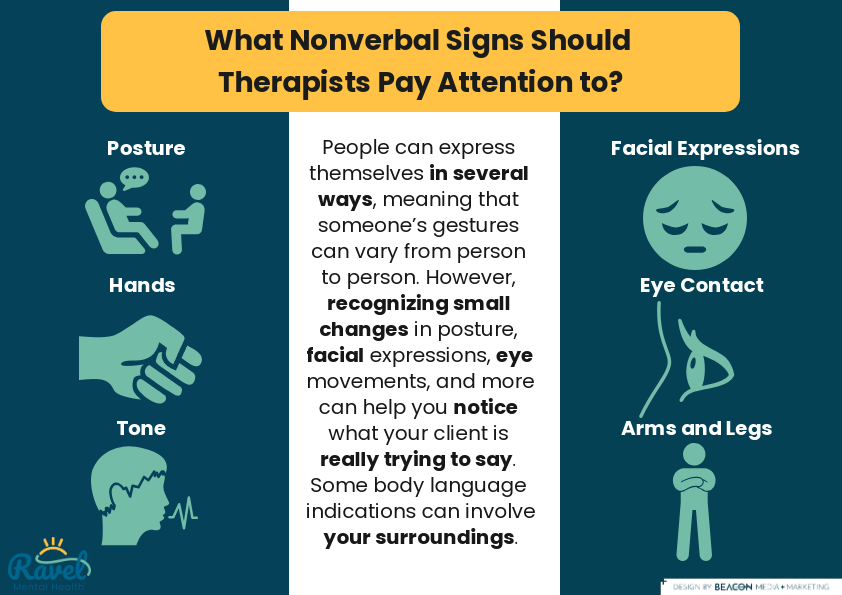Although your client may say, “I’m fine,” they may not be. And as their therapist, you need to know them well enough to tell when that’s not the truth. Understanding their verbal and nonverbal cues is important to help effectively.
But if every client is different, how can you learn both forms of communication to help get to the root of how they might be feeling? Although we’re all unique individuals, we share similar nonverbal communication styles that our subconscious, and sometimes conscious mind, can pick up on. Here is how understanding body language and nonverbal cues in therapy can help you understand your client better and why it’s important to do so.
Are you wanting to connect with more clients? Sign up for Ravel Mental Health today to book more clients!
Why Is Paying Attention to Body Language Important?
As a therapist, your goal is to help your client improve their mental health and achieve a better quality of life. However, connecting with your patient to allow them to open up to you comfortably can be challenging.
When you first meet with a patient, you have to build a relationship and gain trust with someone you just met. And although your words might be the right thing to say, your body language may not indicate your openness to communication and vulnerability. Understanding body language and nonverbal communication are essential for implementing them into your therapy sessions so your clients feel comfortable.
There are instances when, even if you ask your client leading questions about how they’re feeling, they may not be fully honest with you. If you know nonverbal signs, it can make it easier to understand how they truly are feeling. Your client may be showing signs of anxiousness or unease, and you need to know how to calm them so they can open up.
Paying attention to body language is an essential tool for your practice and allows you to connect with your client deeper. It can help you effectively treat your patient and get a more precise diagnosis of what may be going on.
How Does a Therapist’s Body Language Affect a Client During Therapy?
While your client is not responsible for analyzing their body language and aligning that with what they’re saying, it’s essential that you do. As a therapist, it’s part of your job to ensure that your body language is not off-putting to your client. It can keep them from trusting you and may lead to them not opening up to you about their feelings.
Although your client may not be educated in what nonverbal cues means, they can pick up on it through their subconscious. If your verbal and nonverbal language doesn’t match, it tells that person that you’re a person that can’t be trusted. Particularly for clients who have been traumatized by someone in their life that was lying to them, it can create fear, lack of confidence, or insecurity within your client.
As you build a rapport with them, building trust is just as important. So, you should ensure that your body language reflects what you want to convey to your patient and the nature of your relationship. A few examples could include:
- Professional vs Friendly: Your eye contact, body movements, and proximity to them should align with the level of rapport that you’ve built with your client. Some clients may feel uncomfortable with close, friendly proximity, while others may need that comfort style.
- Feedback vs Distance: Posture and eye contact provide the client with the comfort that you’re willing to listen to them to feel heard and appreciated. If your client feels like you’re not interested in their story, they won’t be willing to establish further rapport.
- Mirroring vs Automation: Mirroring a client’s body language can help create a bond with your client that assists in establishing your relationship. Your client’s brain will pick up on body behaviors, and if yours matches theirs, they will subconsciously associate it with a familiarity that allows them to open up to you.
Your body language is essential when building a relationship with your client. Be cognoscente of how you’re acting and ensure that it aligns with your mission to be there for your client.
Do you want to reach more people? Sign up for Ravel Mental Health today to easily connect with new clients!
What Nonverbal Signs Should Therapists Pay Attention to?

People can express themselves in several ways, meaning that someone’s gestures can vary from person to person. However, recognizing small changes in posture, facial expressions, eye movements, and more can help you notice what your client is really trying to say. Some body language indications can involve the following.
Posture
How someone carries themselves can significantly indicate how they’re feeling. It can involve how they truly feel about themselves or how they want to present themselves to the world. If they’re uncomfortable, they may frequently switch positions, or if your client is feeling nervous, unsettled, or afraid, they may:
- Draw back into their seat
- Slouch or hunch forward
- Turn their body slightly away
Hands
Your client’s hand gestures can be a major indicator of the following feelings:
- Anxiety: Trembling fingers or fidgeting their hands
- Anger: Fists clenched or clutched onto something
- Nervousness: Placing a hand on the head or rubbing their head, neck, or lap
- Fear: Holding something as a barrier to protect themselves
Facial Expressions
Facial expressions can be a great indicator of how someone is feeling. Some facial expressions to pay attention to include:
- Eyebrows raised or drawn together can suggest fear or disgust.
- Lowered eyebrows, tense lips, and a set jaw can suggest anger.
- Raised cheeks, drawn-back lip corners, and wrinkles can mean happiness.
- Low lip corners, pouting lower lip, and a crease between the eyebrows can suggest sadness.
- Lip biting might indicate nervousness, and pursed lips could imply disagreement or disapproval.
Eye Contact
Your client’s eye contact is crucial to understanding how they’re feeling. Some factors to pick up on include:
- Looking left and up: visual recall
- Looking left and centrally: auditory recall
- Looking left and down: internal auditory dialogue
- Looking right and up: visual construction
- Looking right and centrally: auditory construction
- Looking right and down: kinesthetic sensation
Arms and Legs
The movement of your client’s arms and legs can indicate their comfort level during the session.
- Defensiveness with crossed arms
- Openness with relaxed arms
- Discomfort with crossed legs
- Boredom, irritation, restlessness, or nervousness with tapping or jiggling legs or feet
Tone
Although tone of voice is more of a verbal cue, it does indicate how someone may be genuinely feeling. If they’re emphasizing certain words, they could be angry or frustrated. Speaking slowly could indicate pain, while a lowered, quiet voice indicates sadness or embarrassment. A higher pitch can show nervousness, dishonesty, or fear.
Listening to clients’ tone of voice will be an excellent tool for you to use when trying to assess their mood about a situation.
How to Pick Up on Nonverbal Cues on Video Calls or Online Therapy
It can already be difficult connecting with your client online. However, trying to understand their nonverbal communication on video can be even more challenging. An element to consider is if they’re sitting in their chair comfortably or uneasy.
Since you can’t see their whole body, you should focus on analyzing their facial expressions and eye contact. If their facial expressions indicate negative emotions, you should adjust the course of the session. In addition, if your client is continuously breaking eye contact to look around the room, then it could indicate that they’re uninterested or anxious.
These cues are critical for fully connecting with your client, especially on an online platform. Utilizing the nonverbal cues can help you better treat them and show you how your body language should be to make them comfortable.
How Can Ravel Mental Health Help You?
Ravel Mental Health is an online platform that allows you to connect with new patients. The high demand for mental health services can make it hard for people to find a therapist that is right for them.
With Ravel Mental Health, your potential clients can learn more about you then book an appointment online. It doesn’t require you to play phone tag to set up an appointment. They can book something with you then you can confirm the appointment.
If you’re ready to connect with more clients in need, no matter your niche, Ravel Mental Health is here to help you.
Are you ready to book more clients? Sign up for Ravel Mental Health today to get started!
